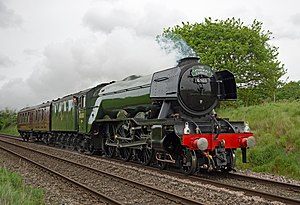| LNER Class A3 No. 60103 Flying Scotsman | |||||||||||||||||||
|---|---|---|---|---|---|---|---|---|---|---|---|---|---|---|---|---|---|---|---|
 Flying Scotsman in 2017 in its British Railways guise, numbered 60103 in BR Brunswick Green livery with German-style smoke deflectors and double chimney. | |||||||||||||||||||
| |||||||||||||||||||
| |||||||||||||||||||
| |||||||||||||||||||
| |||||||||||||||||||
No. 4472 Flying Scotsman is a LNER Class A3 4-6-2 "Pacific" steam locomotive built in 1923 for the London and North Eastern Railway (LNER) at Doncaster Works to a design of Nigel Gresley. It was employed on long-distance express passenger trains on the East Coast Main Line by LNER and its successors, British Railways' Eastern and North Eastern Regions, notably on The Flying Scotsman service between London King's Cross and Edinburgh Waverley after which it was named.
Retired from British Railways in 1963 after covering 2.08 million miles, Flying Scotsman has been described as the world's most famous steam locomotive. It had earned considerable fame in preservation under the ownership of, successively, Alan Pegler, William McAlpine, Tony Marchington, and, since 2004, the National Railway Museum. 4472 became a flagship locomotive for the LNER, representing the company twice at the British Empire Exhibition and in 1928, hauled the inaugural non-stop Flying Scotsman service. It set two world records for steam traction, becoming the first locomotive to reach the officially authenticated speed of 100 miles per hour (161 km/h) on 30 November 1934,[1] and setting the longest non-stop run of a steam locomotive of 422 miles (679 km) on 8 August 1989 while on tour in Australia.
- ^ "The 'Flying Scotsman' Made Train History When The Speedometer Hit 100". Smithsonian magazine. Retrieved 27 June 2023.